Despite its global persistence, the repeated failure of technology outsourcing to deliver the expected results presents a significant problem for organisations1 for approximately 50% of businesses using outsourcing realise ‘poor’ outcomes2.
Our technology solutions are changing faster than ever3, our organisations want and need to consume more technology to solve global problems faster than ever4 and yet, we have for decades been following the same procurement processes for technology. In order to deliver value from technology solutions quickly – that has to change.
What we need now are procurement processes that are focused realising full potential value – faster.
In this article, I argue that technology procurement warrants a new and technology-specific approach that delivers higher value from technology solutions/ services – quickly, while addressing the specific commercial risks and opportunities presented by technology solutions.
In my experience, employing agile practices for technology procurement can help us to overcome the limitations of outdated arms-length RFP processes and to achieve technology procurement that delivers promised results much more quickly, facilitates more creative solutions and reduces the risk produced by out-of-date traditional RFP approaches.
Leveraging my own research and development, practitioner experience and the combined experience of Horizon Seven, I will share the issues caused by traditional-RFP-based procurement, what an agile approach can do to eliminate these issues and maximise opportunities from technology procurement and outline the benefits for buyers and suppliers from cooperating in agile technology procurement.
What’s wrong with RFPs? They served us so well.
In summary, there are four main reasons why RFPs are no longer serving technology procurement well. So why are so many organisations still relying on traditional procurement approaches for technology?
Firstly long, drawn out written procurement processes are too slow. Typical procurement projects take anywhere from 12 to 18 months from conception to service start date which typically isn’t even the point which value is realised, that can come up to 2 years after the procurement starts, this is just too long in today’s markets. Often driving this timeline is the RFP’s wide approach to the market with an overly complex set of complete input requirements, and the need for (too many) suppliers to dictate their response in writing, followed by the lengthy process of evaluating responses and the inevitable ‘beauty parade’.
What we need now are procurement processes that act fast to capture the business requirements and deliver required value as quickly as possible.
Secondly, technology solutions are typically significantly more complex compared to other stuff we procure, arms-length written RFP’s struggle to capture and articulate this complexity, necessarily they also seek to define the solution required from the supplier in order to compare it ‘apples with apples’ against other responses. This approach only serves procurement and the need to administer the responses while minimising risk and cost. RFPs simply don’t allow for co-creativity (between supplier and buyer) and bespoke solution, while also allowing for careful comparison and assessment of risk and value.
What we need now are procurement processes that enable creativity of suppliers to craft solutions (they can in fact deliver), with their buyers to meet business objectives at value for money.
Thirdly, arms-length and waterfall-type processes are not responsive to emerging requirements. No matter how much effort is put into building complex input requirements, things (and information) can change during the process. Macro-economic, micro-internal, new ideas and information discoveries can all crop up changing our requirements. Once the RFP is ‘published’ it is very difficult to adapt and incorporate these kinds of changes. Written arms-length processes do not afford an opportunity to learn from the process and suppliers’ creativity, adapting our requirements and solutions mid-process. In seeking to avoid risk by writing everything down, we create new, greater risk by locking ourselves into fixed requirements.
What we need is an agile, dynamic processes that minimises risk and maximises opportunities by enabling learning/ adapting to emerging requirements mid-process.
Fourth, RFP processes do not allow for competitive approaches to contractual negotiation and commercial design, leaving the negotiation until the back end of the process and treating pricing as a flat best and final approach. In today’s technology market many suppliers can deliver our technical requirements, the competitive landscape needs to include a focus on commercial and contractual solution. By leaving the contractual discussion to the end on BAFO the buyer is left with little leverage, contracts are often too generic, rushed, and carry inherent risk. By running contract and commercial design negotiation alongside solution procurement buyers can expect more creative solutions (better value for money, often more cost-effective), more effective technology contracts and lower risk.
What we need are procurement processes that creatively address the commercial and contractual opportunities and risk in technology solutions.
Why we need Agile approaches to technology procurement?
Research and sourcing practice into the causes of delay, sub-optimal procurement results and long-term post contract issues in the main, stem from poor procurement processes. My research and practice deploying agile practices (agile sourcing) for technology solutions address these (and other) issues with the traditional-RFP approaches to technology procurement. Agile sourcing can achieve;
- A much clearer understanding of the potential benefits (and risks) of the technology solution up front in outcome terms, captured by an effective business-case.
- The move off paper-based requirements and solutions to a collaborative process between the buyer and just a handful of carefully qualified suppliers fuelling creative solutions.
- An agile approach to resetting or adjusting requirements based on learnings during co-creation of solution options maximising opportunities.
- The opportunity to do dynamic down selection of suppliers not meeting requirements or misaligned culturally to your organisation.
- Parallel and competitive contract negotiation dynamically responding to changing requirements tracks to the solution development and delivers a solution-specific contract quickly (sprint contracting).
- An agile and open approach to commercially creative solutions by suppliers that drives value for money for the buyer, maximises opportunity and minimises risk for both parties.
- Open transparency of risk as solution is codeveloped between supplier and buyer, early identification and mitigation of risk is identified at solution design stage.
- Process, solution, and contract is anchored to a business-value based business case which becomes the point of comparison (as opposed to price).
What’s in it for me?
Practice tells us there are benefits for both the buyer and supplier by taking an agile approach to technology procurement – everyone’s a winner!
By taking an agile approach and ditching the written RFP process, the buyer and supplier can quickly get into dialogue about the solution and explore the realities of delivering a solution that meets the business value expectations.
Benefits from taking an agile procurement approach for the buyer
- Accelerates time to value commencement.
- Clarifies and quantifies the risks of unknowns.
- Holds supplier to account for knowns.
- Provides for price certainty and flexibility.
- Removes unnecessary contingency and assumptions by the supplier
- Maximises opportunities from working closely with suppliers to co-create solutions.
Benefits from taking an agile procurement approach for the supplier
- Reduces the competitive field and increases the chance of winning.
- Accelerates time to contract and revenue recognition.
- Addresses the risk of over commitment to unknowns.
- Makes clear the dependencies on the buyer.
- Clarifies and quantifies the risk of unknowns.
- Enables the buyer to be better informed.
- Makes it much easier to identify and add new scope opportunities to the contract.
Comparing the benefits of RFP-procurement with Agile Sourcing
How do I move to agile sourcing?
I believe that the results from agile sourcing over traditional RFP arms-length approaches are infinitely beneficial, not only do they deliver more value – more quickly as well as minimising risk. However, for me the most important benefit is setting up the relationship and delivery for success into the future.
The process for agile sourcing
There are some changes you’ll need to make to adopt agile sourcing;
- A move to a clear business value case from the outset (which can adapt) against which to evaluate the supplier solutions.
- Acceptance that suppliers need freedom to be creative, with you during the process.
- Be prepared to make adaptions and changes which may release opportunities and/or minimise risk during the process.
- Be ready to negotiate contracts with all your shortlisted suppliers during the selection process (which requires more resource).
- Clear understanding of the market of suppliers before going to market, and the ability to intelligently and quickly shortlist.
- Stakeholders will need to get stuck in with a workshop-based process which is quicker, but more intensive for a period (effort which is saved in reviewing many, huge written responses).
- Skills to assess the outcomes of the agile process against the business-value case, and select accordingly.
Concluding remarks
After over a decade practicing, researching and developing agile sourcing (and agile contracting) I have seen first hand the benefit of deploying agile principles to technology procurement, for me the long-term effects of improving the solution and performance of the outsourcing deal is by far the greatest result.
I’m always happy to share the details of agile sourcing helping organisations to get more value more quickly from technology outsourcing is my passion. If you would like to chat more about agile sourcing I’d be very happy to help you understand it better.
Notes:
1: various see below
Bhattacharya, A., Singh, P. J., & Nand, A. A. (2015). Antecedents of buyer opportunistic behavior in outsourcing relationships. International Journal of Production Economics, 166, 258-268.
Gorla, N., & Somers, T. M. (2014). The impact of IT outsourcing on information systems success. Information & management, 51(3), 320-335.
Kim, S., & Chung, Y. S. (2003). Critical success factors for IS outsourcing implementation from an interorganizational relationship perspective. Journal of Computer information systems, 43(4), 81-90.
Koh, C., Ang, S., & Straub, D. W. (2004). IT outsourcing success: A psychological contract perspective. Information systems research, 15(4), 356-373.
Ngwenyama, O., & Sullivan, W. (2007). Outsourcing contracts as instruments of risk management: Insights from two successful public contracts. Journal of Enterprise Information Management, 20(6), 615–640.
Qi, C., & Chau, P. (2013). Investigating the roles of interpersonal and interorganizational trust in IT outsourcing success. Information Technology & People (West Linn, Or.), 26(2), 120–145.
Schwarz, C. (2014). Toward an understanding of the nature and conceptualization of outsourcing success. Information & Management, 51(1), 152–164.
Wolverton, C. C., Hirschheim, R., Black, W. C., & Burleson, J. (2020). Outsourcing success in the eye of the beholder: Examining the impact of expectation confirmation theory on IT outsourcing. Information & Management, 57(6), 103236.
2: Lacity, M., & Willcocks, L. (2017). Conflict resolution in business services outsourcing relationships. The Journal of Strategic Information Systems, 26(2), 80-100.
3: Wahiba, N. F., & Mahmoudi, D. (2023). Technological change, growth and income inequality. International Journal of Economics and Financial Issues, 13(1), 121-131. doi:https://doi.org/10.32479/ijefi.13831
4: Mokhber, M., Vakilbashi, A., Zamil, N. A. M., & Basiruddin, R. (2016). Impact of entrepreneurial leadership on organization demand for innovation: Moderating role of employees’ innovative self-efficacy. International Review of Management and Marketing, 6(3), 415-421.














